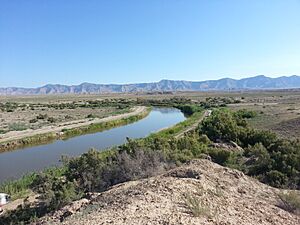Government Highline Canal facts for kids
The Government High Line Canal is a really important waterway in Colorado. It's also called the Grand Valley Project. This canal flows along the northern part of the Grand Valley, close to a city called Grand Junction.
The canal was built by a part of the U.S. government called the U.S. Bureau of Reclamation. This group helps create big water projects. The canal is still owned by the government today, thanks to a law from 1902.
Contents
Building the Grand Valley Canal
The U.S. Bureau of Reclamation is a government agency. Its job is to build large irrigation projects. These projects include dams and canals. They helped people settle and farm in the western United States.
Work on the Government Highline Canal began in 1902. It was finished in 1917. There were some delays because of private landowners. The government needed their land for the project.
Canal Size and Water Flow
The canal is 55 miles long. It carries a lot of water! It can move about 1,675 cubic feet of water every second. Imagine a box 1 foot by 1 foot by 1 foot. That's one cubic foot. So, it moves 1,675 of those boxes of water each second.
The project also includes a special structure. It's a 14-foot-high concrete wall. This wall is called a diversion weir. It's on the Colorado River. This weir helps send water into four other canals. These canals stretch for over 90 miles in the area.
Early Plans for the Canal
In 1903, a group in Grand Junction had an idea. They suggested that a private company build the canal. They thought private money could fund it. However, after several years, it was clear this wouldn't work. Private construction didn't happen.
In 1909, a group of U.S. Army engineers met. They decided the project was possible. The U.S. government then set aside $1.5 million for it. This money would build the Highline Canal system. It also paid for roads along the canal for maintenance. Today, $1.5 million would be worth over $38 million!
Keeping the Canal Working
By the mid-1930s, parts of the canal started to wear out. Wooden structures were breaking. Tunnels showed signs of damage. Even the roads and banks along the canal were getting old.
The U.S. government stepped in again in 1935. The Civilian Conservation Corps (CCC) helped out. The CCC was a program during the Great Depression. Young men worked on public projects. They set up camps near the canal. They began to fix and improve the canal's features.
Canal's Impact on the Region
This amazing irrigation project was paid for by public money. It helped the area's farming industries grow. Famous crops like fruit and wine became possible. The canal allowed farmers to make a living from their land for many years.
Today, the Grand Valley Water Users Association manages the canal. They lease it from the U.S. government. This group is a non-profit organization. They charge users a fee for the water. This money helps operate and maintain the canal.


